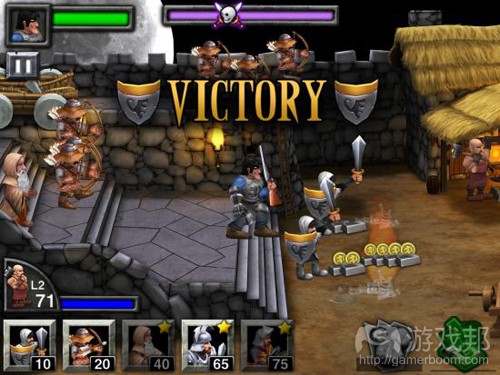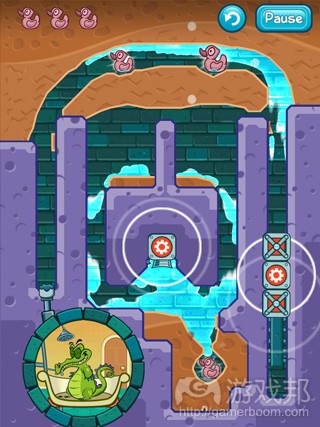Pocket Gamer评2012年度10大手机游戏开发商
作者:Jon Jordan
制作新手机游戏以及为在线游戏提供支持的发行商和开发商有数千个,所以选出排名前50的开发商是件相当困难的事情。
在这个过程中,我们有创造力、外界评价、销售表现以及业务模式创新等指标,与手机应用分析公司Flurry共同评选出前50手机游戏公司。
以下是此列表中排名前10的手机游戏公司:
1、Rovio(上升1名)
如果以目前的名望来看,Rovio只发布过3款游戏,分别在2009、2010和2011年,而且从本质上来说这些游戏都是相同的,它位于这份榜单首位似乎是件很荒谬的事情。
诚然,该公司要做的事情还有很多,包括其业务模式以及未来的发展等。但是单纯从数字上来看,该公司位居首位是无可争议的。其游戏总下载量超过7亿次,每月广告印象上百亿次,2011财年公司盈利为1亿美元,该公司的估价已超过20亿美元。
所以,重点并不在于《愤怒的小鸟》缺乏创新,而是Rovio罕见的发展速度,简单且富有吸引力的游戏玩法、优秀的合作伙伴、持续更新的热情,这些都是值得推崇的要点。正是这些做法使原本默默无闻的团队成为世界上最著名的娱乐品牌之一。
没有哪家西方游戏公司的发展速度能与之匹敌,这也是Rovio成为行业典范的原因之一。
2、Halfbrick(上升5名)
澳大利亚开发商Halfbrick是个真正专注于游戏的公司。它并没有开创新的业务模式(游戏邦注:该公司使用其他人的业务模式),而是将全部精力放在游戏开发上,使每款发布的游戏都能够成为精品。
2011年最精致的游戏《Jetpack Joyride》便出自这家公司。
游戏最初公布的名称为《Machinegun Jetpack》,但是在后续的开发中,公司不断扩展游戏玩法。Halfbrick满怀信心,修改了游戏的名称,并用一系列开发视频解释了原因。运营模式也颇让人放心,定价99美分,并设置IAP功能。该游戏在29个国家的应用商店中位居游戏营收榜单之首。
当然,Halfbrick最为人熟知的产品依然是《水果忍者》,这款游戏已经发布到4个平台上(游戏邦注:这是Halfbrick唯一在Windows Phone发布的一款游戏),而且还有绝妙的Kinect版本,该游戏的总下载量超过1亿次。
但是,与其他成功工作室不同的是,Halfbrick只是将自己视为游戏开发商,而不是个娱乐品牌。这才是该公司的实力所在。
3、EA Mobile(上升7名)
对于EA及其移动部门来说,2011年真是一个丰收年。它曾经跌出2011年前10大手机游戏公司排行榜,但是这个西方最大的手机游戏发行商2011年销售额达到2.3亿美元,所以又重返该榜单。
最令众人震惊的是其极具雄心的收购战略——耗资7.5亿美元收购PopCap。PopCap的1/3盈利来自于手机领域,这个举措能够有效地推动EA Mobile业务发展。2011年,EA Mobile还收购了Firemint和Bight Games等开发商。2010年10月,iOS发行商Chillingo也被收购。
经过如此多项收购交易后,EA Mobile在手机游戏品牌和关键技术领域方面掌握了大量资源。它还同第三方发行商合作,比如同Thunder Game合作发布《Trenches II》。
Origin社交平台以及《Theme ParkTetris》等免费游戏也对公司排名的上升发挥了作用。公司还整合了疯狂美式橄榄球和FIFA等原有品牌,iOS版本《FIFA 12》发布首周便售出87.9万份。该公司在2012年将更上一层楼。
4、PopCap(上升1名)
根据我之前的观点,对PopCap来说,2011年要么是没落的开始,要么是不成熟期的结束。公司及其购买方EA都期望是后者这种情况。
尽管公司未透露具体数值,但据猜测PopCap在2010年的手机销售额提升了50%,超过3000万美元,这主要归功于公司的Java业务和在iOS上的快速成长。自此开始,公司迅速构建庞大的手机网络,发布了多款游戏,包括Android版《植物大战僵尸》以及Windows Phone版《宝石迷阵》,并在GREE等日本平台上发布游戏。
公司还向外界展示了丰富的商业和游戏玩法创造力,将iOS游戏《宝石迷阵2》和《宝石迷阵闪电战》分拆成付费和免费游戏分别发布。但是,公司试行的4th & Battery品牌并没有获得很大的成功。
公司的做法是将游戏制作完善后再发布,同时对现有IP提供完美的支持,我们期待2012年该公司能够发布更多令人兴奋的产品。
5、Backflip Studios(上升4名)
美国开发商Backflip Studios仍在飞速发展。从《Paper Toss》等简单的免费游戏开始,公司不断地积聚活跃用户。这样,制作更多游戏并用交叉推广来调动玩家激情便使Backflip构建起每月多达数十亿次广告印象业务,这些广告包括纯商业广告以及推动游戏下载和IAP消费的内部广告。
《Army of Darkness: Defense》的发布显示了该公司在提升游戏图像和游戏玩法质量上的抱负,这是款带有IAP的付费游戏,取材于Sam Raimi的电影《鬼玩人》。
该公司于2011年末发布的iOS游戏《DragonVale》让工作室在行业内的声望突飞猛进。在这款集饲养、种植、竞争和分享的游戏中,玩家可以捕捉、收集、训练、自定义和哺育可爱的小龙,游戏在60个国家的应用商店中位居游戏营收榜单之首,同时也促使Backflip突破了1.5亿次下载量。
因为有这些成功作铺垫,该公司有望成为免费增值游戏市场的巨头之一。
6、NimbleBit(上升16名)
该公司成员为孪生兄弟Ian Marsh和David Marsh,虽然是个小型公司,但NimbleBit绝不是一夜成名的。公司旗下游戏包括《Scoops》和《Sky Burger》。公司发布iOS游戏的历史可以追溯到2008年,发布过许多精致且富有吸引力的游戏。而且,重要的是,该公司适应了快速改变的业务模式。
事实上,2010年9月公司就决定进入免费游戏领域,其发布的绝妙免费游戏《Pocket Frogs》正可以说明这点。这款游戏属于最早利用社交性的游戏之一,获得了巨大的成功。日本商DeNA迅速将Android版本移植到其Mobage网络上。
但是,真正引起业界关注的是《Tiny Tower》。这款游戏有上千万的下载量,日活跃用户上百万,而且获得“苹果年度游戏”这一殊荣。它的成功向外界展示了免费增值模式的吸引力。讽刺的是,这款游戏使包括Zynga在内众多公司与NimbleBit对立,NimbleBit指责这些公司了抄袭《Tiny Tower》的机制和风格。
7、Gameloft(下降6名)
作为游戏发行公司,或许财报才是可用来衡量Gameloft的唯一指标。如果从这个方面来看,该公司的表现很不错,2011财政年度收益提升17%,达到2.13亿美元左右。
然而,在这些光鲜的数字背后,Gameloft发现自己处在进退两难的境地。公司的成长基础是技术强大的开发过程,比如游戏支持多种设备以及将开发地设在低成本国家。这种做法在功能性手机市场(游戏邦注:该市场收益仍占公司总收益的59%),以及第一代付费智能手机游戏这两个领域确实很奏效。
但是,免费模型的崛起使市场发生了变化。公司核心用户对此产生强烈的反应,所以我们才会看到《Dungeon Hunter》和《Gangstar》表现异常。而且,公司似乎还未考虑涉足以Zynga的Ville系列游戏为代表的休闲市场。
同时,强劲对手EA Mobile也花费重金收购优秀团队和品牌,新一波的社交游戏发行商和独立公司的成功正逐步蚕食着市场发展机遇。在这种背景下,我们应当能够在2012年看到Gameloft如何重振市场影响力。
8、Chair Entertainment(下降4名)
在今年的排行中,让Epic Games旗下的Chair Entertainment下降4名似乎是很不恰当的做法,毕竟《无尽之剑2》取得了很大的成功,这款游戏被众人视为完美的续作。但是,如果注意到手机游戏市场的发展速度,就能够理解我们的这种做法。
毫无疑问,Chair确实提升了自己的游戏,《无尽之剑2》在原作的基础上构建而成,融入了硬核游戏玩法和令人震撼的画面,同时在易用性、控制和可用性上符合休闲游戏的标准。据称该系列游戏目前已使Chair获利3000万美元,这足以说明这种方法是成功的。
但本榜单也考虑到技术和业务模式等因素,所以这款游戏也只能被视为“类似主机游戏”的作品,该公司在这一点上相对逊色于其他开发商。
比如,目前Android已支持虚幻引擎,但《无尽之剑》仍然只是款iOS平台游戏,这着实令人惊异。虽然日本DeNA的Mobage平台上已推出该游戏免费版本,但Epic和Chair似乎仍然还有许多未抓住的机遇。
9、ZeptoLab(上升6名)
ZeptoLab很容易被人看作是小型Rovio:该公司旗下99美分的游戏由Chillingo发行,并且一夜成名。从某种程度上来说,这个由Voinov兄弟成立的俄罗斯开发商显然想走Rovio路线,将其成功品牌进行扩展、移植及更新,制作成漫画和其他商品。
ZeptoLab较小,因而更为专注,它有着自己的发展方法。而且,公司旗下还有款游戏名为《Parachute Ninja》,这款游戏的发布要早于《割绳子》。但是相比Rovio,该公司似乎对开发新IP更有激情,这是2012年值得期待之事。
《割绳子》现在的下载量已超过8500万次(游戏邦注:25%付费版本,75%免费版本),而且不久后还将在Windows Phone和Symbian平台上发布,同时将登陆Chrome等浏览器。显然,公司在手机和游戏行业的发展与提升游戏角色Om Nom的影响力密切相关。
10、迪士尼(新晋榜单)
虽然迪士尼是世界级的媒体品牌,但之前并没有将过多精力放在手机游戏行业,仅仅是推出了《玩具总动员》、《汽车总动员》和《创:战纪》等电影授权游戏。尽管该公司于2010年7月耗资3500万美元收购《Tap Tap Revenge》开发商Tapulous,但似乎也并没有对市场产生很大的影响。
虽然Tapulous开发团队大部分成员在收购后离开公司,但2011年迪士尼确实同Tapulous合作推出了新产品。
解谜游戏《Where’s My Water?》于9月份在iOS平台发布,这款游戏让我们认识了洗澡鳄鱼Swampy这个角色,游戏自发布后便久居应用商店营收榜单前10强之列。游戏售价99美分(游戏邦注:该游戏带有IAP),它的成功也证明了免费增值模式并非唯一的发展之路。自游戏在Android平台发布后,仅圣诞节一周内的下载量便超过600万次(游戏邦注:包括付费和免费版本)。
《Club Penguin》衍生游戏《Puffle Launch》的成功也预示着手机游戏业务对迪士尼日益重要,期待这个米老鼠工场能够在2012年推出更多产品。
附:Pocketgamer 2012年其他前50名手机游戏公司名单(排序从低到高)
50. Full Fat
49. Andreas Illiger
48. Neon Play
47. RedLynx
46. PlayFirst
45. Cave
44. SkyVu
43. Mojang
42. Miniclip
41. Digital Chocolate
40. Armor Games
39. Z2Live
38. Red Robot Labs
37. CrowdStar
36. Get Set Games
35. Game Insight
34. Limbic Software
33. G5 Entertainment
32. TinyCo
31. 11 bit studios
30. Kairosoft
29. Sega
28. Funzio
27. HandyGames
26. Madfinger Games
25. DeNA/ngmoco
24. Crescent Moon
23. Big Fish Games
22. Fishlabs
21. Pocket Gems
20. Chillingo
19. NaturalMotion
18. Spacetime Studios
17. Glu Mobile
16. Com2uS
15. Storm8/TeamLava
14. Konami
13. Capcom Mobile
12. Zynga
11. Gamevil
(本文为游戏邦/gamerboom.com编译,拒绝任何不保留版权的转载,如需转载请联系:游戏邦)
The PocketGamer.biz top 50 developers of 2012: 10 to 1
Jon Jordan
Considering the many thousands of publishers and developers who are daily making new mobile games and supporting live titles, the task of picking out the relatively small number of 50 as being ‘top’ may seem to be a Sisyphean exercise.
Yet, that process provides a wealth of useful information, while the rigor of directly comparing companies – one against another – forces us to think about what we mean by the term ‘top developers’.
In terms of our process at PocketGamer.biz, we used metrics such as creativity, critical acclaim, sales performance, innovation especially in terms of business model, and that certain je ne sais quoi that only the best studios exude.
The full list – produced in conjunction with leading mobile application analytics and advertising platform Flurry – can be found in our Top 50 Developer of 2012 section.
Disney
New entry
Despite its status as one of the world’s iconic media brands, Disney hadn’t previously demonstrated much awareness of the mobile games industry, other than typical licensing operations for tie-in releases such as Toy Story, Cars and Tron. Even the $35 million acquisition of Tap Tap Revenge developer Tapulous in July 2010 didn’t seem to have much impact.
Still, although the majority of the Tapulous development team have since left, 2011 was the year that synergies between Disney’s character-led business and the experience of the three Tapulous execs now running the unit really took off.
Released in September for iOS, liquid puzzler Where’s My Water? – which introduced us to the character of Swampy the showering crocodile – has remained in the top 10 top grossing charts ever since. Indeed, as 99c game (with IAP), it’s a demonstrated that the freemium model isn’t the only route to take. Since released for Android, Disney revealed over six million versions of the game (paid and free) where downloaded using the Christmas week.
The importance of mobile to Disney’s wider business has also been underlined by the success of Club Penguin companion game Puffle Launch. Expect plenty more from the House of the Mouse on both fronts in 2012.
ZeptoLab
Up 6
It’s easy to see ZeptoLab as something of a mini-Rovio; based in northern Europe, its 99c game published by Chillingo, a one-hit wonder. And to some degree, it’s clear that the Russian developer, set up by the Voinov brothers, is following the route trailblazed by the Finnish studio in terms of expanding one successful brand with expansions, ports, updates, comics and other merchandising.
A much smaller and hence more focused company, it has its own way of doing things. For one thing, it has another game, Parachute Ninja, which pre-dates Cut the Rope. Perhaps related, it appears to be much more enthusiastic about releasing new IP; something that’s expected to see the light of day in 2012.
Yet, with Cut the Rope now having been downloaded over 85 million times (25 percent paid, 75 percent free), and soon making its debut on Windows Phone and Symbian – not to mention its arrival on browsers like Chrome – it’s clear the company’s continued stratospheric rise as a mobile and gaming heavyweight largely depends on how far and fast it can push the game’s sweet-eating hero Om Nom.
Chair Entertainment
Down 4
It might seem churlish that Epic Games-owned Chair Entertainment slips four places in this year’s ranking, considering the success of Infinity Blade II; a game that could be described as being close to the perfect sequel. But that would be forgetting the comparative speed of development in the mobile games market, especially in the rarefied atmosphere of the top 10.
There’s no question that Chair has upped its game, with Infinity Blade II building on the original’s foundation in terms of mixing hardcore gameplay and cutting edge graphics, with a casual approach in terms of accessibility, control and usability. The success of the approach can be judged by the announcement that the franchise has grossed $30 million to-date.
Still, taking into account the broader elements of technology and business that our list is also built on, an attitude that could be described as ‘console-like’, sees the developer overtaken by other companies, comparatively at least.
For example, given the support of its underlining Unreal engine for Android, it’s surprisingly that Infinity Blade remains an iOS-only franchise. And while there is a free-to-play version available in Japan on DeNA’s Mobage platform, there remains plenty of opportunities to better merge its console and mobile qualities if Epic and Chair so desired.
Gameloft
Down 6
Perhaps, as a public company, the only metrics that matter to Gameloft are quarterly financials. On that basis, it’s in fine form, with its FY11 sales up 17 percent to around $213 million.
Yet, behind these numbers, Gameloft finds itself in something of a schizophrenic situation. Its growth has been built on the back of technically strong development process, both in terms of the range of devices supported, as well as its location in low cost countries. This has worked very well in terms of the feature phone market, which still consists of 59 percent of sales, and the first generation of premium paid games on smartphones.
The rise of the free-to-play model has upset its equilibrium, however. There’s been a strong backlash from its core audience, which have seen solid franchises such as Dungeon Hunter and Gangstar reworked in a confusing manner. Nor has the company got to grips with the very lucrative casual mobile market characterised by Zynga’s Ville games.
Meanwhile, arch rival EA Mobile has spent big to acquire expertise and brands, and a new wave of social publishers and indie success stories are soaking up opportunities. In this context, 2012 will demonstrate to what extent Gameloft has the determination to reinvent itself.
NimbleBit
Up 16
Despite its boutique status – the company consists of twins Ian and David Marsh – NimbleBit is no overnight success story. With games such as Scoops and Sky Burger, it’s been at the forefront of iOS gaming since 2008, always releasing polished and attractive titles at a rate of knots; and, as importantly, learning from the fast changing business models.
Indeed, it was back in September 2010 that it decide to move into free gaming, demonstrating its chops with the excellent free-to-play game Pocket Frogs. One of the earliest releases in the sector to use sociability in a positive manner, it was a quiet but strong success; something underlined as Japanese platform holder DeNA quickly snapped up the Android version for its Mobage network.
But it was Tiny Tower, a game highlights the pair’s attention to detail and presentational flair, that captured the plaudits. With 10 million downloads, one million daily active users and an Apple Game of the Year award, it demonstrates the attraction of a less aggressive form of the freemium model. It is ironic then that it’s since been generated controversy with several companies, including Zynga, accused of cloning its mechanics and/or style.
Backflip Studios
Up 4
The rise and rise of US developer Backflip continues apace. Starting out with simple and typically free iOS titles such as Paper Toss, it’s steadily accumulated a large network of active players. In this way, feeding more games into the mix and cross promoting them to existing players has enabled Backflip to build up a billion-strong monthly ad impression-based business that mixes pure advertising with house ads to drive further game downloads and in-app purchases.
It also demonstrated its ambition to up the graphical and gameplay quality of its games with the release of Army of Darkness: Defense, a paid game with IAP, which was based on the Sam Raimi film.
However, it was the release of its first from-the-ground-up free-to-play iOS game DragonVale in late 2011 that really propelled the studio’s reputation sky high. A nurturing, farming, competing and sharing game that has players hatching, collecting, training, customising and breeding cute dragons, it’s been the #1 top grossing game in 60 countries, as well as bumping Backflip to over 150 million lifetime downloads.
Already a success story, the company now has the potential to become a key player in the fast expanding freemium market.
PopCap
Up 1
Depending on your point of view, 2011 was either the beginning of the end, or the end of the beginning for PopCap. Both it and purchaser EA expect it’s the latter, with the combined operation looking extremely robust when it comes to mobile games.
Detailed figures were never revealed, but it was thought that PopCap’s mobile sales in 2010 were up 50 percent year-on-year to over $30 million, thanks mainly to its bedrock Java business and fast growth on iOS. The company has since quickly built out a wider mobile reach, releasing multiple titles such as key IP Plants vs Zombies on Android – including an exclusive period on Amazon’s Appstore, and support for Kindle Fire – plus a version of Bejeweled with IAP for Windows Phone, and games on Japanese platform such as GREE.
It also demonstrated a burst of commercial and gameplay creativity, splitting its Bejeweled 2 + Blitz iOS game into separate paid and free-to-play releases (its first on mobile). Its experimental 4th & Battery label proved less successful, however, with its “smaller, stranger, edgier games” failing to find an audience.
Still, with a strong focus on not rushing new games until they are ready, while heavily supporting existing IP, we expect more exciting things in 2012.
EA Mobile
Up 7
What a year for EA and its mobile division. Widely reckoned to be underperforming in our 2011 list, the largest mobile publisher in the west, with annual sales of $230 million in 2011, really bounced back.
Most eye-opening was its aggressive acquisition strategy, which saw it spending at least $750 million to buy PopCap. Considering around a third of PopCap’s revenue comes from mobile, this will strengthen EA Mobile’s business going forward. Other additions during the year included developers Firemint and Bight Games. iOS publisher Chillingo was acquired in October 2010.
The result is that EA Mobile has considerable firepower in terms of its mobile brands and internal expertise in key areas. It’s also working hard on its third party publishing, partnering with Thunder Game Works for Trenches II, although Battlefield 3 is currently lost in development hell.
Other strings to its bow going forward include its Origin social platform, experimentations with free-to-play games such as Theme ParkTetris. Add into the mix strong recurring brands such as Madden and FIFA – with the iOS version of FIFA 12 selling 879,000 units in its launch week – and 2012 should be a bumper year.
Halfbrick
Up 5
Australian developer Halfbrick is one of those companies that is all about the games. It isn’t showy in terms of its business models (although it’s using most of them), nor does it hype its own considerable success. Instead, it works quietly, with a laser focus on ensuring each release as good as it can be.
It’s an attitude underlined in one of 2011′s most polished games – Jetpack Joyride.
Originally unveiled as Machinegun Jetpack, subsequent development saw the gameplay extended, but such was Halfbrick’s confidence, it was happy to rename the game, explaining its reasoning with a series of developer video diaries. The business model was also confident, with a 99c price (since free) backed with in-app purchases. It’s been the #1 top grossing game in 29 countries.
Of course, Halfbrick’s still best known for Fruit Ninja, which is has been released on four platforms (it’s Halfbrick’s only game on Windows Phone), not to mention an excellent Kinect version, and movie tie-in release with Puss in Boots. Total downloads are well over 100 million units, and you can buy plush toys too.
Yet, unlike other successful studios, you know Halfbrick sees itself a game developer, not an entertainment brand. That’s its real strength.
Rovio
Up 1
Given that in its current incarnation, Rovio has only released three games – one in 2009, 2010 and 2011 – and each is essentially the same, it might seem ridiculous to award it the #1 position in the PocketGamer.biz top 50 developer list.
Certainly, there are plenty of strong views about the company in terms of what it should do next, its business model, future longevity and general attitude, but stripped down to bare numbers, you can’t argue with 700+ million downloads, 10 billion ad impressions per month, $100 million annual revenue in FY11, and a company valuation that doesn’t seem ridiculous at $2+ billion – not matter what you think about the Mighty Eagle’s maths.
So the point isn’t that Angry Birds lacks innovation, but that a combination of first mover advantage in a market expanding as fast as anything in human history, simple and compelling gameplay, a brilliant signature tune, great partnerships, constant updates, and however you want to define it – luck – turned an almost bust team into one of the best known entertainment brands on the planet.
No other (western) company will rise so high, so fast, making Rovio our industry’s exemplar, and one we should all be proud of. (Source: Pocket Gamer)













































 闽公网安备35020302001549号
闽公网安备35020302001549号